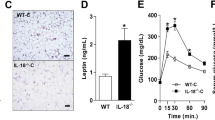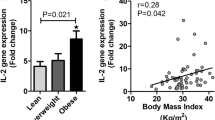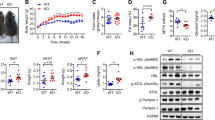Abstract
Objective:
Obesity is associated with chronic inflammation of the adipose tissue, which contributes to obesity-associated complications such as insulin resistance and type 2 diabetes. Interleukin (IL)-33 acts via its receptor ST2 and is involved in the pathogenesis of inflammatory disorders including atherosclerosis and heart disease. IL-33 has been demonstrated to promote endothelial cell inflammatory response, but also anti-inflammatory and protective actions such as TH2 and M2 polarization of T cells and macrophages, respectively. IL-33 and ST2 have been shown to be expressed in human and murine adipose tissue. Our objective was to investigate alterations in obesity and a possible role of IL-33 in adipose tissue inflammation.
Subjects and methods:
We investigated severely obese patients (BMI>40 kg m−2, n=20) and lean to overweight controls (BMI<30 kg m−2; n=20) matched for age and sex, as well as diet-induced obese and db/db mice, in order to determine the impact of obesity on IL-33 and ST2 gene and protein expression levels in adipose tissue and blood, and their correlation with inflammatory and metabolic parameters. Furthermore, we examined the cellular source and location of IL-33 and ST2 in situ.
Results:
IL-33 and ST2 expression levels were markedly elevated in omental and subcutaneous adipose tissue of severely obese humans and in diet-induced obese mice, but not in leptin receptor-deficient db/db mice. In addition, soluble ST2, but not IL-33 serum levels, were elevated in obesity. The main source for IL-33 in adipose tissue were endothelial cells, which, in humans, exclusively expressed ST2 on their surface. IL-33 expression strongly correlated with leptin expression in human adipose tissue.
Conclusions:
Expression of IL-33 and its receptor ST2 in human adipose tissue is predominantly detectable in endothelial cells and increased by severe obesity indicating an autocrine action. Thus, the adipose tissue microvasculature could participate in obesity-associated inflammation and related complications via IL-33/ST2.
This is a preview of subscription content, access via your institution
Access options
Subscribe to this journal
Receive 12 print issues and online access
$259.00 per year
only $21.58 per issue
Buy this article
- Purchase on Springer Link
- Instant access to full article PDF
Prices may be subject to local taxes which are calculated during checkout






Similar content being viewed by others
References
Vykoukal D, Davies MG . Vascular biology of metabolic syndrome. J Vasc Surg 2011; 54: 819–831.
Donath MY, Shoelson SE . Type 2 diabetes as an inflammatory disease. Nat Rev Immunol 2011; 11: 98–107.
Zeyda M, Stulnig TM . Obesity, inflammation, and insulin resistance–a mini-review. Gerontology 2009; 55: 379–386.
Fernandez-Riejos P, Najib S, Santos-Alvarez J, Martin-Romero C, Perez-Perez A, Gonzalez-Yanes C et al. Role of leptin in the activation of immune cells. Mediators Inflamm 2010; 2010: 568343.
Rasouli N, Kern PA . Adipocytokines and the metabolic complications of obesity. J Clin Endocrinol Metab 2008; 93: S64–S73.
Rabe K, Lehrke M, Parhofer KG, Broedl UC . Adipokines and insulin resistance. Mol Med 2008; 14: 741–751.
Ouchi N, Parker JL, Lugus JJ, Walsh K . Adipokines in inflammation and metabolic disease. Nat Rev Immunol 2011; 11: 85–97.
Zeyda M, Farmer D, Todoric J, Aszmann O, Speiser M, Gyori G et al. Human adipose tissue macrophages are of an anti-inflammatory phenotype but capable of excessive pro-inflammatory mediator production. Int J Obes (Lond) 2007; 31: 1420–1428.
Anderson EK, Gutierrez DA, Hasty AH . Adipose tissue recruitment of leukocytes. Curr Opin Lipidol 2010; 21: 172–177.
Zhao W, Hu Z . The enigmatic processing and secretion of interleukin-33. Cell Mol Immunol 2011; 7: 260–262.
Liew FY, Pitman NI, McInnes IB . Disease-associated functions of IL-33: the new kid in the IL-1 family. Nat Rev Immunol 2010; 10: 103–110.
Kuchler AM, Pollheimer J, Balogh J, Sponheim J, Manley L, Sorensen DR et al. Nuclear interleukin-33 is generally expressed in resting endothelium but rapidly lost upon angiogenic or proinflammatory activation. Am J Pathol 2008; 173: 1229–1242.
Wood IS, Wang B, Trayhurn P . IL-33, a recently identified interleukin-1 gene family member, is expressed in human adipocytes. Biochem Biophys Res Commun 2009; 384: 105–109.
Schmitz J, Owyang A, Oldham E, Song Y, Murphy E, McClanahan TK et al. IL-33, an interleukin-1-like cytokine that signals via the IL-1 receptor-related protein ST2 and induces T helper type 2-associated cytokines. Immunity 2005; 23: 479–490.
Iwahana H, Yanagisawa K, Ito-Kosaka A, Kuroiwa K, Tago K, Komatsu N et al. Different promoter usage and multiple transcription initiation sites of the interleukin-1 receptor-related human ST2 gene in UT-7 and TM12 cells. Eur J Biochem 1999; 264: 397–406.
Westcott DJ, Delproposto JB, Geletka LM, Wang T, Singer K, Saltiel AR et al. MGL1 promotes adipose tissue inflammation and insulin resistance by regulating 7/4hi monocytes in obesity. J Exp Med 2009; 206: 3143–3156.
Pascual-Figal DA, Ordonez-Llanos J, Tornel PL, Vazquez R, Puig T, Valdes M et al. Soluble ST2 for predicting sudden cardiac death in patients with chronic heart failure and left ventricular systolic dysfunction. J Am Coll Cardiol 2009; 54: 2174–2179.
Daniels LB, Clopton P, Iqbal N, Tran K, Maisel AS . Association of ST2 levels with cardiac structure and function and mortality in outpatients. Am Heart J 2010; 160: 721–728.
Shah RV, Januzzi JL . ST2: a novel remodeling biomarker in acute and chronic heart failure. Curr Heart Fail Rep 2010; 7: 9–14.
Weir RAP, Miller AM, Murphy GEJ, Clements S, Steedman T, Connell JMC et al. Serum soluble ST2: a potential novel mediator in left ventricular and infarct remodeling after acute myocardial infarction. J Am Coll Cardiol 2010; 55: 243–250.
Oboki K, Ohno T, Kajiwara N, Arae K, Morita H, Ishii A et al. IL-33 is a crucial amplifier of innate rather than acquired immunity. Proc Natl Acad Sci USA 2010; 107: 18581–18586.
Miller AM, Xu D, Asquith DL, Denby L, Li Y, Sattar N et al. IL-33 reduces the development of atherosclerosis. J Exp Med 2008; 205: 339–346.
Sanada S, Hakuno D, Higgins LJ, Schreiter ER, McKenzie AN, Lee RT . IL-33 and ST2 comprise a critical biomechanically induced and cardioprotective signaling system. J Clin Invest 2007; 117: 1538–1549.
Miller A . Role of IL-33 in inflammation and disease. J Inflamm (Lond) 2011; 8: 22.
Miller AM, Asquith DL, Hueber AJ, Anderson LA, Holmes WM, McKenzie AN et al. Interleukin-33 induces protective effects in adipose tissue inflammation during obesity in mice. Circ Res 2010; 107: 650–658.
Kurowska-Stolarska M, Stolarski B, Kewin P, Murphy G, Corrigan CJ, Ying S et al. IL-33 amplifies the polarization of alternatively activated macrophages that contribute to airway inflammation. J Immunol 2009; 183: 6469–6477.
Zeyda M, Stulnig TM . Adipose tissue macrophages. Immunol Lett 2007; 112: 61–67.
Lumeng CN, Bodzin JL, Saltiel AR . Obesity induces a phenotypic switch in adipose tissue macrophage polarization. J Clin Invest 2007; 117: 175–184.
Clement K, Viguerie N, Poitou C, Carette C, Pelloux V, Curat CA et al. Weight loss regulates inflammation-related genes in white adipose tissue of obese subjects. FASEB J 2004; 18: 1657–1669.
Winer S, Chan Y, Paltser G, Truong D, Tsui H, Bahrami J et al. Normalization of obesity-associated insulin resistance through immunotherapy. Nat Med 2009; 15: 921–929.
Zeyda M, Huber J, Prager G, Stulnig TM . Inflammation correlates with markers of T-cell subsets including regulatory T cells in adipose tissue from obese patients. Obesity (Silver Spring) 2011; 19: 743–748.
Fain JN, Madan AK, Hiler ML, Cheema P, Bahouth SW . Comparison of the release of adipokines by adipose tissue, adipose tissue matrix, and adipocytes from visceral and subcutaneous abdominal adipose tissues of obese humans. Endocrinology 2004; 145: 2273–2282.
Moussion C, Ortega N, Girard JP . The IL-1-like cytokine IL-33 is constitutively expressed in the nucleus of endothelial cells and epithelial cells in vivo: a novel 'alarmin'? PLoS One 2008; 3: e3331.
Yamagishi SI, Edelstein D, Du XL, Kaneda Y, Guzman M, Brownlee M . Leptin induces mitochondrial superoxide production and monocyte chemoattractant protein-1 expression in aortic endothelial cells by increasing fatty acid oxidation via protein kinase A. J Biol Chem 2001; 276: 25096–25100.
Bouloumie A, Marumo T, Lafontan M, Busse R . Leptin induces oxidative stress in human endothelial cells. FASEB J 1999; 13: 1231–1238.
Curat CA, Miranville A, Sengenes C, Diehl M, Tonus C, Busse R et al. From blood monocytes to adipose tissue-resident macrophages: induction of diapedesis by human mature adipocytes. Diabetes 2004; 53: 1285–1292.
Demyanets S, Konya V, Kastl SP, Kaun C, Rauscher S, Niessner A et al. Interleukin-33 induces expression of adhesion molecules and inflammatory activation in human endothelial cells and in human atherosclerotic plaques. Arterioscler Thromb Vasc Biol 2011; 31: 2080–2089.
Aoki S, Hayakawa M, Ozaki H, Takezako N, Obata H, Ibaraki N et al. ST2 gene expression is proliferation-dependent and its ligand, IL-33, induces inflammatory reaction in endothelial cells. Mol Cell Biochem 2010; 335: 75–81.
Choi Y-S, Choi H-J, Min J-K, Pyun B-J, Maeng Y-S, Park H et al. Interleukin-33 induces angiogenesis and vascular permeability through ST2/TRAF6-mediated endothelial nitric oxide production. Blood 2009; 114: 3117–3126.
Aron-Wisnewsky J, Tordjman J, Poitou C, Darakhshan F, Hugol D, Basdevant A et al. Human adipose tissue macrophages: M1 and M2 cell surface markers in subcutaneous and omental depots and after weight loss. J Clin Endocrinol Metab 2009; 94: 4619–4623.
Acknowledgements
This work was supported by the Austrian National Bank (ÖNB; project no. 12735), the European Community’s 7th Framework Program (FP7/2007–2013) under grant agreement no. 201608, the Christian Doppler Forschungsgesellschaft (all to TMS), and the Austrian Science Fund (FWF; project no. P18776-B11 to TMS and T445-B11 to SD). We would like to thank Marion Gröger and Sabine Rauscher from the Imaging Core Facility of the Medical University of Vienna for their cooperation in confocal microscopy.
Author information
Authors and Affiliations
Corresponding author
Ethics declarations
Competing interests
The authors declare no conflict of interest.
Rights and permissions
About this article
Cite this article
Zeyda, M., Wernly, B., Demyanets, S. et al. Severe obesity increases adipose tissue expression of interleukin-33 and its receptor ST2, both predominantly detectable in endothelial cells of human adipose tissue. Int J Obes 37, 658–665 (2013). https://doi.org/10.1038/ijo.2012.118
Received:
Revised:
Accepted:
Published:
Issue Date:
DOI: https://doi.org/10.1038/ijo.2012.118
Keywords
This article is cited by
-
Characteristic and fate determination of adipose precursors during adipose tissue remodeling
Cell Regeneration (2023)
-
sST2 Levels Show No Association with Helicobacter pylori Infection in Asymptomatic Patients: Implications for Biomarker Research
Digestive Diseases and Sciences (2023)
-
Prebiotic/probiotic supplementation resulted in reduced visceral fat and mRNA expression associated with adipose tissue inflammation, systemic inflammation, and chronic disease risk
Genes & Nutrition (2022)
-
Transcriptome of visceral adipose tissue identifies an inflammation-related ceRNA network that regulates obesity
Molecular and Cellular Biochemistry (2022)
-
IL-25 directly modulates adipocyte function and inflammation through the regulation of adiponectin
Inflammation Research (2022)



